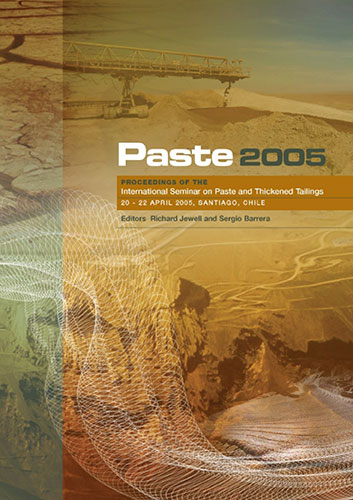Bulyanhulu Mine (Tanzania) Paste Tailings Facility: Relating the unsaturated properties of gold tailings to rate of rise

|
Authors: Theron, M; Addis, PC; Wates, JA; Martin, V |
DOI https://doi.org/10.36487/ACG_repo/563_15
Cite As:
Theron, M, Addis, PC, Wates, JA & Martin, V 2005, 'Bulyanhulu Mine (Tanzania) Paste Tailings Facility: Relating the unsaturated properties of gold tailings to rate of rise', in R Jewell & S Barrera (eds), Paste 2005: Proceedings of the International Seminar on Paste and Thickened Tailings, Australian Centre for Geomechanics, Perth, pp. 219-229, https://doi.org/10.36487/ACG_repo/563_15
Abstract:
Bulyanhulu Mine in Tanzania is an underground gold mine. Tailings are pro- duced and used in part for paste as underground backfill material. The balance of the tailings is deposited on the surface as a paste. Research is currently underway to determine the optimum method of deposition. The mechanical behaviour of the tailings was assessed by means of a field monitoring program. Various soil parameters such as gravimetric moisture content, suction pressure and, in-situ density were measured for a period of approximately three months on a freshly deposited beach. Measurements were taken at regular intervals between the dis- charge point and the toe of the beach on a daily basis. The results of the field monitoring program provided valuable information on the unsaturated soil behaviour with particular reference to the air entry value and moisture retention curve. 220 Paste 2005, Santiago, Chile Bulyanhulu Mine Paste Tailings... Theron, M. et al.
References:
Aubertin, M., Richard, J. and Chapuis, R.P. (1998) A predictive model for the
water retention curve: Application to tailings from hard-rock mine. Canadian
Geotechnical Journal. Vol. 35, pp. 55-69 (with Erratum, 36:401).
ASTM D422-63 (2002) Standard Test Method for Particle-Size Analysis of Soils,
ASTM International.
ASTM D-1556 (1982) Standard Test Method for sand cone method, ASTM In-
ternational.
BS1377: Part 2 (1990) British standard methods of tests for soils of civil engineer-
ing, Technical report. British Standards Institution, London.
Chadwick, A. and Morfett, J. (1993) Hydraulics in civil and environmental engi-
neering. 2nd ed. E & FN Spon, London.
Paste 2005, Santiago, Chile 229
Surface Disposal
Concoli, N.C. and Sills, G.C. (2000) Soil formation of predictions and field mea-
surements. Geotechnique, Vol. 50, No. 1, pp. 25-33.
Das, B.M. (1995) Principles of geotechnical engineering. 3rd Ed. PWS Publishing
company.
Fredlund, D.G. and Rahardjo, H. (1993) Soil mechanics for unsaturated soils.1st
ed. John Wiley and Sons Inc.
Kovacs, G. (1981) Seepage hydraulics. Elsevier Science Publishers, Amersterdam.
Rassam, D.W. and Williams, D.J. (1999) Unsaturated hydraulic conductivity of
mine tailings under wetting and drying conditions. Geotechnical testing journal,
Vol. 22, No. 2, pp. 144-154.
Ridley, A.M., Patel, A.R. and Marsland, F. (1998) Tensiometers; their use for civil
engineering purposes. Proceedings of the 1st international conference on site
characterisation, Atlanta. Robertson P. K. and Mayne P. W. (Ed), A. A. Balkema,
pp. 851-865.
Ridley, A.M. and Wray, W.K. (1996) Suction measurement: A review of current
theory and practices. Proceedings of the 1st international conference on unsatur-
ated soils, Paris, Alonso A. A. and Delarge P. (Ed), A. A. Balkema, pp. 701-708.
Terzaghi, K. (1936) The shear resistance of saturated soils. Proceedings of the 1st
international conference soil mechanics and foundation engineering. Vol. 1, pp.
54-56.
© Copyright 2026, Australian Centre for Geomechanics (ACG), The University of Western Australia. All rights reserved.
View copyright/legal information
Please direct any queries or error reports to repository-acg@uwa.edu.au
View copyright/legal information
Please direct any queries or error reports to repository-acg@uwa.edu.au